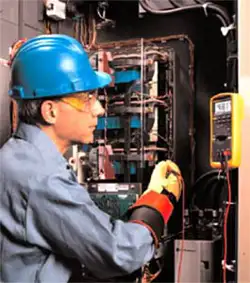Electrical Safety In The Workplace

Arc Flash Training CSA Z462 - Electrical Safety Essentials
Our customized live online or in‑person group training can be delivered to your staff at your location.

- Live Online
- 6 hours Instructor-led
- Group Training Available
Download Our OSHA 4474 Fact Sheet – Establishing Boundaries Around Arc Flash Hazards

- Understand the difference between arc flash and electric shock boundaries
- Learn who may cross each boundary and under what conditions
- Apply voltage-based rules for safer approach distances
Electrical safety workplace practices minimize electrical hazards through OSHA compliance, NFPA 70E procedures, lockout/tagout, arc flash risk assessment, proper grounding, PPE selection, safe isolation, and testing protocols for energized equipment and circuits.
The Complete Guide to Electrical Safety in the Workplace
The importance of electrical safety in the workplace cannot be overstated. Safe practices are essential for protecting the health and safety of workers, as well as shielding employers from legal liability. In the United States, the Occupational Safety and Health Administration (OSHA) governs workplace electrical safety, while in Canada, the Canadian Electrical Code (CEC) sets the standard for electrical safety practices. For context on workplace obligations, consult electrical safety requirements that clarify compliance expectations.
Visit Our NFPA 70E Arc Flash Training Course Page
Visit Our CSA Z462 Arc Flash Training Course Page
NFPA 70E Standard for Electrical Safety in the Workplace
The "NFPA 70E Standard is a comprehensive set of guidelines designed to minimize the risk of hazards, such as arc flash and shock, in commercial and industrial settings. Developed by the National Fire Protection Association (NFPA), this standard provides employers, safety professionals, and workers with best practices for working safely around electricity. To strengthen implementation, organizations often rely on arc flash safety training that aligns teams on consistent procedures.
What Are the Key Principles of Electrical Safety in the Workplace?
The foundation of electrical safety is based on several key principles designed to reduce the risk of injury. These principles are important for ensuring a safer working environment and preventing contact with exposed omponents. For fundamental concepts, review basic electrical safety to reinforce hazard awareness.
- De-energization: One of the most crucial principles is de-energizing equipment before any work is performed. De-energization ensures that equipment is not live while being repaired or maintained, significantly reducing the risk of electric shock.
- Lockout/tagout procedures: These procedures ensure that energized equipment is properly isolated from its energy source and that it cannot be re-energized while work is ongoing. Lockout/tagout is essential for preventing accidental energization, which could lead to injuries.
- Use of personal protective equipment (PPE): Wearing appropriate PPE, such as insulated gloves, boots, and safety goggles, can help workers avoid electrical hazards, including shock and burns.
By following these principles, workers can mitigate risks and work more safely around potentially hazardous systems. Detailed methods are outlined in electrical safety procedures that support consistent application in the field.
Sign Up for Electricity Forum’s Arc Flash Newsletter
Stay informed with our FREE Arc Flash Newsletter — get the latest news, breakthrough technologies, and expert insights, delivered straight to your inbox.
What Are the Most Common Electrical Hazards in the Workplace?
Several common hazards are present in work environments, and understanding these risks is critical for preventing injuries. The most frequently encountered hazards include:
A broader summary is provided in electrical safety resources that explain risk controls across industries.
- Contact with exposed parts: Accidental contact with exposed components is a major cause of electric shock. This can occur if insulation is damaged, equipment is not properly maintained, or workers are not following safe work practices.
- Improper use of extension cords and cords: Overloading extension cords or using damaged cords can result in overheating, fires, and electric shocks.
- Ground faults: A ground fault occurs when current takes an unintended path to the ground, creating a risk of electric shock. Ground faults are especially dangerous in wet conditions or when using faulty equipment.
- Failure to de-energize equipment: Working on energized equipment without properly de-energizing it can lead to fatal injuries, including severe burns or electric shock.
Recognizing these common hazards can help workers avoid hazards and ensure a safer work environment. In industrial settings, additional guidance on controls appears in industrial electrical safety materials that address high-energy systems.
What Safety Precautions Should Workers Take When Working with Electrical Equipment?
Workers must take specific precautions to prevent injuries and maintain a safer working environment. Following these safety tips can minimize the risks associated with equipment:
Supervisors can reinforce these practices using electrical safety work checklists that standardize daily routines.
- Inspect electrical cords and extension cords regularly: Damaged cords or frayed wires should be replaced immediately. Additionally, avoid overloading extension cords to prevent overheating and potential fires.
- Follow proper de-energization procedures: Ensure that equipment is fully de-energized and locked out before performing any maintenance or repairs. Lockout/tagout procedures should always be in place when working with energized equipment.
- Maintain a safe distance from exposed components: Workers should be cautious of contact with exposed parts and should wear insulated gloves and PPE when working in close proximity to these components.
- Use ground fault circuit interrupters (GFCIs): GFCIs can prevent shock by detecting ground faults and shutting off power when needed, especially in wet or damp areas.
- Never assume equipment is de-energized: Always use a testing device to verify that equipment is not live before starting work.
By following these safety precautions, workers can better protect themselves from electric shock and other potential injuries.
How Often Should Electrical Safety Training Be Conducted for Employees?
Training is an essential component of electrical safety in the work environment. Employees must understand the dangers involved with electricity and how to avoid them. Electrical safety training should be conducted regularly, at least once a year, and should be updated if there are significant changes in the work environment, such as new equipment or revised safety protocols.
Ongoing education about hazards, safe work practices, and the proper use of PPE is vital for minimizing risks. Employers should also provide refresher courses to ensure employees remain informed about the latest safety standards.
Who Is Responsible for Ensuring Electrical Safety in the Workplace?
Responsibility for electrical safety falls on both employers and employees. Employers are required to implement safe work practices, conduct risk assessments, and provide the necessary PPE to protect workers. They are also responsible for conducting regular safety audits, ensuring that systems and equipment are maintained, and enforcing lockout/tagout procedures.
Employees, on the other hand, are responsible for following safety protocols, using protective equipment, and reporting any unsafe conditions. Workers must remain vigilant in avoiding hazards and adhere to all established safety procedures.
Together, employers and employees must work to create a safer working environment by preventing injuries and ensuring that all equipment and protocols are followed.
Hazards are present in nearly every industry, and without proper precautions, they can lead to serious injuries. By understanding the key principles of electrical safety, recognizing common hazards, and following safe work practices, employers and employees can prevent accidents and maintain a safer work environment. Regular training and adherence to lockout/tagout procedures are essential in reducing the risks associated with energized equipment, helping to ensure the safety and well-being of everyone involved.
FREE EF Electrical Training Catalog
Download our FREE Electrical Training Catalog and explore a full range of expert-led electrical training courses.

- Live online and in-person courses available
- Real-time instruction with Q&A from industry experts
- Flexible scheduling for your convenience







